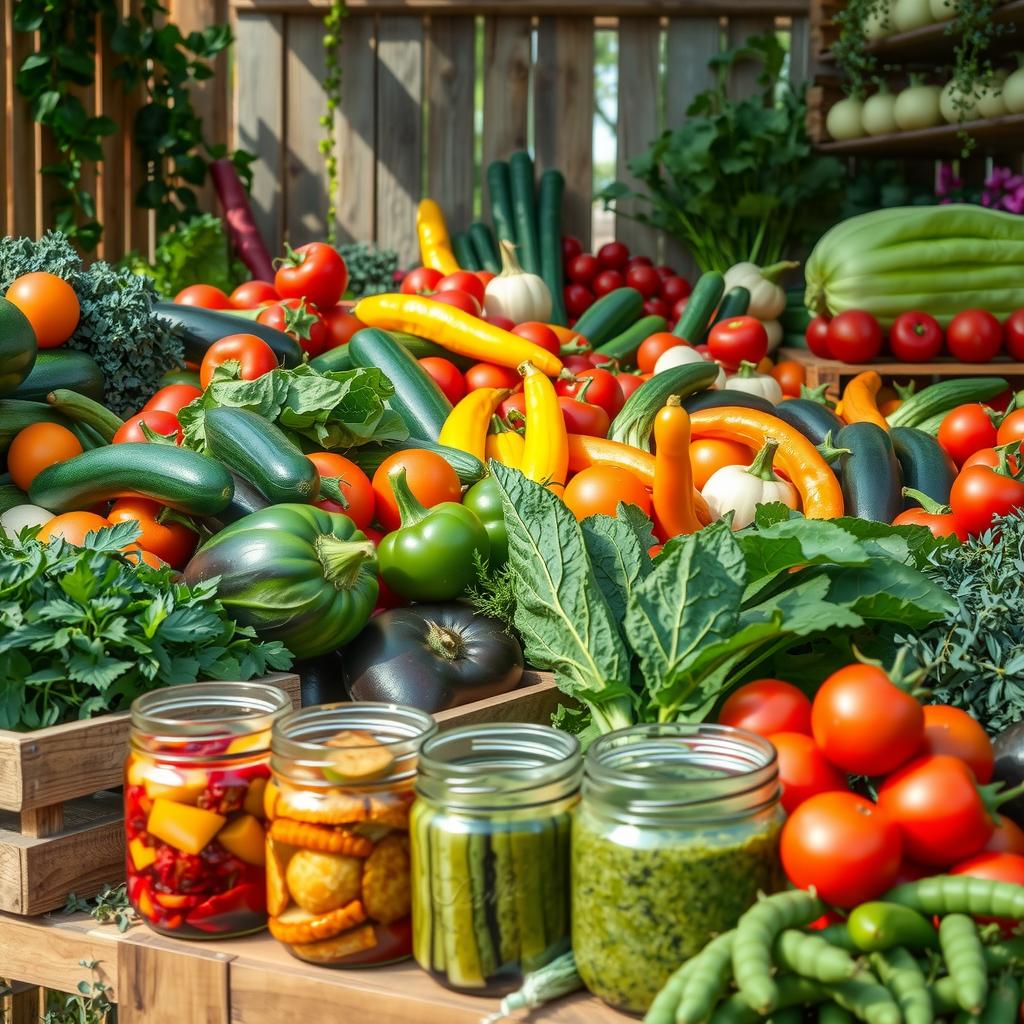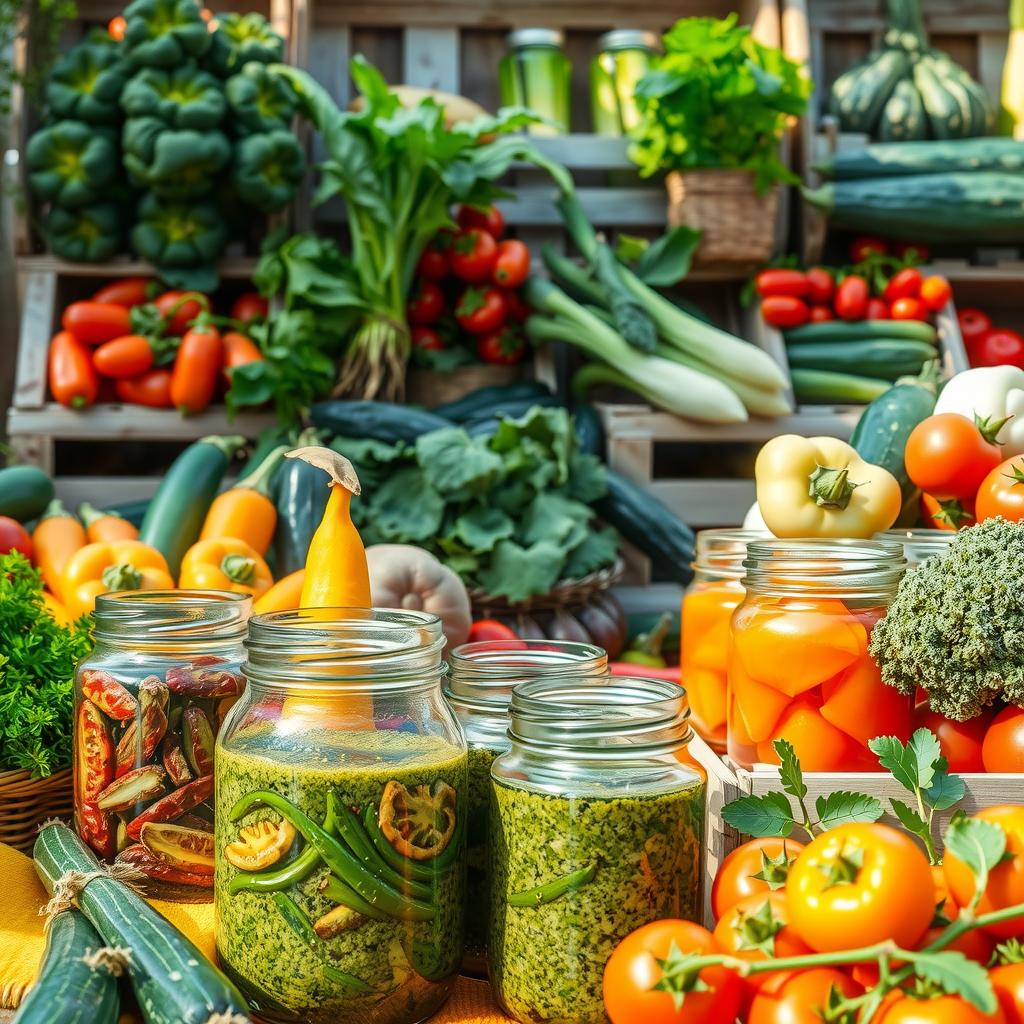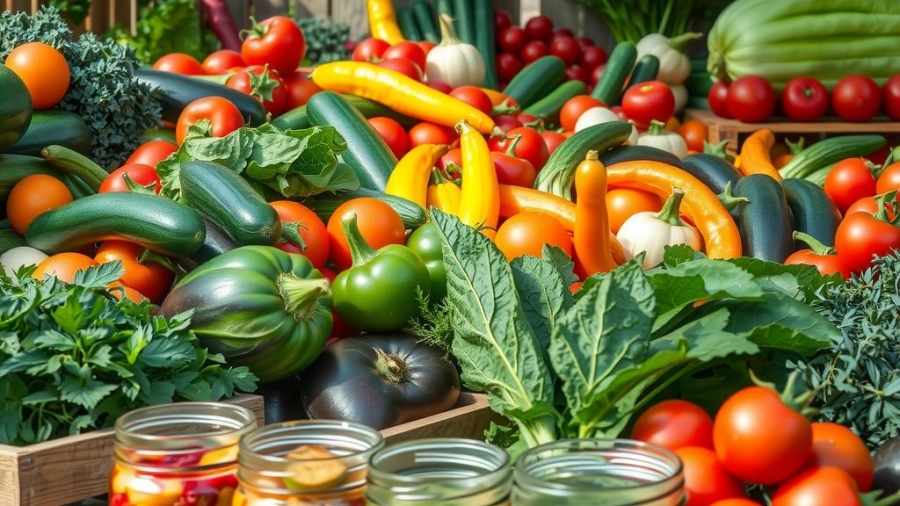As the summer sun shines brightly, gardens and local farmers’ markets burst with an abundance of colorful produce. However, this vegetable surplus can quickly become overwhelming for those eager to enjoy seasonal flavors throughout the year. The challenge lies in finding effective food preservation techniques that not only extend the lifespan of these vibrant summer vegetables, but also maintain their taste and nutritional value. With a little knowledge about various preservation methods, anyone can turn their harvest into delicious meals long after the warm months have passed.
This article aims to equip readers with practical strategies for safe and efficient food storage that caters specifically to summer’s bounty. From time-honored canning methods designed to lock in freshness, to innovative approaches such as freezing vegetables or utilizing advanced dehydration methods, there are numerous options available for every home cook regardless of experience level. Each technique offers unique benefits that cater to different preferences and kitchen setups.
The importance of proper crop management cannot be overstated when it comes to maximizing what is harvested during peak seasons. By implementing effective food preservation practices now, individuals can savor the essence of summer while ensuring minimal waste—something all conscientious consumers strive for today. Moreover, understanding how best to store seasonal produce allows families not only to save money but also contribute positively toward sustainability efforts.
By delving deeper into this guide on preserving your garden’s treasures through tried-and-true techniques paired with modern innovations, readers will discover new ways they can keep their kitchens stocked year-round. Whether one is interested in learning how freeze fresh veggies at home or mastering essential steps in creating shelf-stable jars filled with homemade goodness, this post promises valuable insights worth exploring further!

Key Points:
- Canning Techniques: Transforming Fresh Produce into Long-lasting Delights Mastering canning methods allows gardeners to convert their vibrant summer vegetables into delicious sauces and pickles. By following safe procedures, individuals can preserve the flavors of their harvests, ensuring they have tasty options available throughout the winter months. This technique not only extends shelf life but also enhances meal variety by incorporating home-canned goodies.
- Freezing for Convenience: Locking in Flavor with Minimal Effort For those seeking a quick and efficient way to manage their vegetable surplus, freezing offers an ideal solution. By properly preparing and storing fresh produce in freezers, individuals can maintain the original texture and nutrients of their seasonal produce. This method is particularly beneficial for busy households that wish to enjoy garden-fresh flavors without extensive preparation time later on.
- Exploring Dehydration Methods: Unique Textures and Flavors Year-round Dehydration provides another innovative approach to preserving summer’s bounty. Utilizing various dehydration methods, such as air-drying or using specialized equipment, cultivators can create unique snacks like sun-dried tomatoes or crispy kale chips. These preserved items bring diverse textures and tastes to culinary creations throughout the year while effectively minimizing waste from any excess crop management efforts.
By employing these effective strategies within one’s gardening routine, it becomes possible to relish the delectable outcomes of a thriving garden long after summer has faded away.

Transforming Fresh Produce into Lasting Delights
Unleashing the Power of Canning for Summer Vegetables
Canning is an age-old food preservation method that empowers individuals to transform their summer vegetables into enduring culinary delights. As harvest season approaches, many face the challenge of a surplus of crops. Rather than letting this bounty go to waste, canning offers a fantastic solution that allows for extended enjoyment beyond the growing season. By employing effective canning techniques, fresh produce such as tomatoes, cucumbers, and bell peppers can be preserved in jars filled with savory sauces or tangy pickles. This transformation not only retains essential nutrients but also enhances flavors through the process of cooking and sealing these ingredients in airtight containers.
The process begins with selecting high-quality seasonal produce; freshness directly impacts flavor and longevity during storage. After thoroughly washing and preparing vegetables—whether by chopping or blanching—home cooks can choose from various preservation techniques tailored to their preferences: boiling water bath canning for high-acid foods like pickles or pressure canning suitable for low-acid options like green beans. Each method serves its purpose in ensuring safety while maximizing shelf-life. For instance, proper sterilization is crucial; jars must be heated adequately before filling them with prepared mixtures to eliminate bacteria effectively.
Once sealed correctly, canned goods provide an accessible way to enjoy summer’s bounty year-round without compromising taste or nutrition. For those who may find themselves overwhelmed by garden yields, embracing these food preservation techniques transforms excess vegetables into delightful pantry staples ready at any moment—a comforting thought during winter months when local produce becomes scarce.
Preserving Nutritional Value Through Canning
A Sustainable Approach to Food Storage
In addition to extending shelf life and enhancing flavors, one significant advantage of using canning methods lies in preserving nutritional value effectively. When done properly, canned goods retain a substantial amount of vitamins and minerals found in fresh fruits and vegetables compared to other food storage methods like freezing or dehydration—which often lead to nutrient loss over time due mainly due exposure factors involved during processing stages (e.g., heat). Moreover, choosing home-canned options mitigates concerns regarding preservatives commonly found within commercially packaged products.
A well-executed jarred creation provides convenience as well; imagine reaching for homemade tomato sauce on a busy weeknight rather than opting for store-bought varieties loaded with additives! The versatility inherent within preserved items means they seamlessly integrate into countless recipes—from hearty stews featuring vibrant mixed veggies straight from one’s own garden harvests—to zesty salads complemented by home-pickled cucumbers bursting with flavor far surpassing anything purchased off grocery store shelves.
Furthermore, adopting sustainable practices aligns perfectly alongside managing environmental impact considerations surrounding agriculture today—the journey toward achieving zero-waste ideals starts right at home! By investing time into learning essential skills involving crop management through knowledge acquisition about successful harvesting times combined expertly coupled alongside mastering effective food storage solutions—individuals contribute positively towards global efforts focused on reducing unnecessary waste throughout different agricultural sectors worldwide.
Expanding Horizons Beyond Traditional Canning
Exploring Alternative Preservation Techniques
While traditional canning remains undoubtedly popular among enthusiasts looking forward each year eagerly awaiting peak seasons ripe fruits & veggies available locally—it’s prudent not overlook additional alternatives available designed suit diverse needs/preferences across households everywhere! Methods such as freezing allow gardeners easy access meals packed full nutritious goodness despite shopping limitations present outside summertime windows!
Moreover another option worth exploring includes dehydration processes whereby moisture extracted results longer-lasting snacks while maintaining original characteristics intact still retaining distinct textures/flavors making ideal munchies enjoyed anytime anywhere without worry spoiling quickly if left too long unattended kitchen counters etc..
Ultimately understanding importance utilizing multiple forms effective food preservation ensures everyone finds ways best suited fit unique lifestyles thereby sustaining healthier eating habits whilst enjoying impressive array delicious dishes created entirely out surplus grown locally harvested treasures alike!
Best Practices for Freezing Vegetables
A Guide to Retaining Flavor and Nutrients
Freezing vegetables is an effective way to maximize freshness, especially during the harvest season when seasonal produce is abundant. By employing proper preservation techniques, busy households can benefit from the convenience of having nutrient-rich options readily available throughout the year. The process begins with selecting high-quality, ripe vegetables that are at their peak; this ensures that they will retain both flavor and nutrients after freezing. It’s essential to wash them thoroughly to remove any dirt or pesticides before cutting them into appropriate sizes for storage. Blanching—a quick cooking process involving boiling and then shocking in ice water—helps in preserving color, texture, and nutritional value by deactivating enzymes that can lead to spoilage even when frozen. This method proves beneficial particularly for summer vegetables such as green beans, peas, or carrots.
After blanching, it’s crucial to dry the vegetables properly before placing them in airtight containers or freezer bags designed for food storage. This step not only prevents freezer burn but also maintains optimal quality over time. When packaging these items, removing as much air as possible from the bags helps prevent oxidative damage while retaining vibrant colors and flavors within each vegetable piece. For those who wish to store larger quantities due to a garden surplus or local farmer’s market bounty, investing in a vacuum sealer might be advantageous; it effectively removes air while sealing contents tightly together without compromising on freshness.
Efficient Food Storage Techniques
Simplifying Your Freezing Routine
For many households managing a busy lifestyle amidst various responsibilities like work and family engagements, finding efficient methods of food preservation becomes paramount. Using frozen vegetables allows families easy access to healthy meals without requiring lengthy preparation times typically associated with fresh produce that may spoil quickly if not used promptly. Moreover, incorporating frozen veggies into dishes significantly reduces waste stemming from unused perishables—an important consideration given how often people encounter excess crops during peak harvest seasons.
In addition to freezing methods mentioned earlier, alternatives such as dehydration methods provide another viable option for long-term food storage if space permits fewer freezer requirements or electricity isn’t accessible consistently due infrastructure limitations across regions worldwide where farming occurs regularly . Canning remains popular too; however ,it demands more time investment than what many individuals have available on tight schedules today compared traditional ways done previously generations ago which involved laborious processes ensuring everything sealed correctly jars could last years!. Regardless of chosen method(s), embracing these practices guarantees your family enjoys flavorful meals enriched with vitamins derived directly harvested plants rather than processed counterparts laden additives preservatives potentially affecting health negatively down road! Thus empowering consumers manage their kitchens better through understanding how best utilize nature resources around them efficiently sustainably – promoting overall well-being along journey life itself!
Innovative Techniques in Culinary Preservation
Unlocking the Potential of Dehydration for Year-Round Enjoyment
The art of dehydration offers a unique opportunity to enhance culinary creativity while effectively addressing food preservation challenges. As summer vegetables thrive, many home cooks find themselves grappling with a vegetable surplus, leading them to explore various preservation techniques that not only prolong freshness but also introduce exciting textures and flavors into their dishes. One popular method, air drying, allows moisture to evaporate naturally under warm conditions, resulting in crispy herbs and fruit leathers that can elevate salads or serve as nutritious snacks. Meanwhile, using an electric dehydrator provides controlled heat settings for consistent results; it is ideal for preserving seasonal produce such as tomatoes or zucchini. The beauty of these dehydration methods lies in their ability to intensify flavors—think sun-dried tomatoes bursting with a concentrated taste—and create delightful textural contrasts that enrich any meal throughout the year.
Elevating Culinary Experiences
Creative Uses of Dehydrated Ingredients
Incorporating dehydrated ingredients into everyday cooking opens up avenues for imaginative dining experiences. For instance, crushed dehydrated vegetables can serve as robust seasonings when sprinkled on popcorn or mixed into dips. Furthermore, rehydrating fruits like apples or mangoes brings back their original sweetness while adding depth to baked goods and breakfast bowls alike. With an array of options at hand—ranging from dried mushrooms enhancing broths to vegetable powders fortifying sauces—the possibilities are endless when chefs embrace this technique fully. The versatility inherent in these products makes them indispensable allies in managing food storage effectively during off-seasons while minimizing waste—a crucial element considering today’s emphasis on sustainability within kitchens.
Seasonal Adaptability
Mastering Crop Management Through Dehydration
Harnessing the power of dehydration aligns seamlessly with effective crop management strategies by ensuring no part of harvest goes unused. Rather than allowing excess produce from summer planting seasons deteriorate post-harvest due to spoilage risks associated with traditional canning methods or even freezing vegetables—which may alter texture—dehydration stands out as both efficient and flavor-preserving option suitable across all seasons. This technique empowers individuals cultivating gardens at home: they become adept at making informed decisions about which crops best lend themselves towards drying processes based on individual preferences or market trends observed throughout different months’ growth cycles highlighting particular varieties ripe for use come autumn’s chill.
Nutritional Benefits and Storage Solutions
Encouraging Healthy Eating Habits via Dried Produce
Nutritionally speaking, integrating dried fruits and veggies fosters healthier eating habits without sacrificing taste quality! Whether seeking convenient snack alternatives packed full nutrients equivalent—or higher than fresh forms depending upon preparation methods used—that retain essential vitamins through careful handling practices yields significant health benefits worth noting! Moreover—as families strive towards reducing reliance pre-packaged foods laden preservatives opting instead wholesome solutions—it becomes imperative examine how incorporating varying types preserved offerings contributes positively overall dietary patterns observed today amongst diverse populations seeking clean eating lifestyles amid increasingly busy schedules marked rapid consumption norms prevalent society currently faces daily demands posed modern living environments must adapt accordingly meet expectations successfully every time mealtime arrives!
Conclusion: A Flavorful Future Ahead
Through creative exploration utilizing unique hydration approaches not only preserves seasonal produce but enhances culinary artistry year-round enriching diets promoting healthy choices accessible everyone regardless level expertise kitchen talents displayed consistently over time promising flavorful futures ahead!
Frequently Asked Questions:
Q:What are some effective methods for preserving summer vegetables?
A:There are several effective food preservation techniques available for managing a surplus of summer vegetables. Popular methods include canning, freezing, and dehydration. Canning allows you to transform fresh produce into long-lasting items like sauces or pickles, while freezing is an easy way to lock in freshness with minimal effort. Dehydration provides unique textures and flavors that enhance the culinary experience throughout the year.
Q:How does canning work as a food preservation method?
A:Canning is a process that involves sealing food in airtight containers after heating them to destroy bacteria and enzymes that cause spoilage. Proper canning methods ensure safety and quality by creating a vacuum seal during cooling. This technique is especially beneficial for preserving juicy crops like tomatoes, which can be transformed into savory sauces or zesty pickles.
Q:Is freezing vegetables an efficient way to preserve them?
A:Yes, freezing vegetables is one of the most convenient food storage options available for busy households looking to manage their vegetable surplus effectively. By blanching fresh produce briefly before placing them in airtight bags or containers, individuals can lock in nutrients and flavor while extending shelf life significantly—making it an excellent choice for enjoying seasonal produce well beyond summer’s end.
